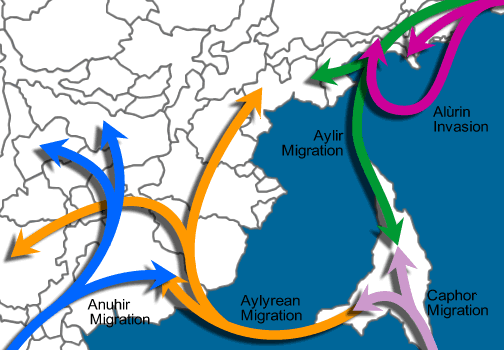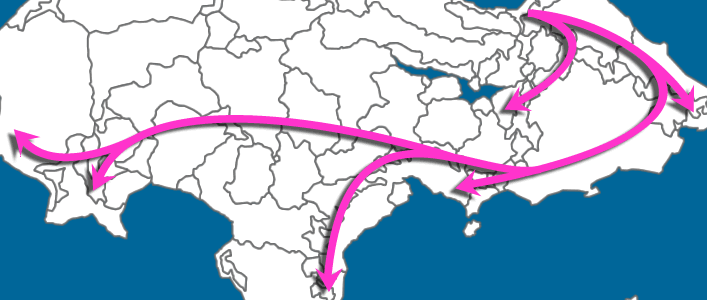The Edge of History
The Fifth Migration is often referred to as the Tassèri Expansion, for during this period the Yrūn scattered across the face of the last continent, settling in each of its four corners. The migrations however did not stop in Tassèrus. Subsequent movements introduced people to Ælyra and the eastern coast of Teréðor, a “reunion” that saw the reintroduction of Yrūn populations after fourteen centuries of moving in opposite directions. This meeting of wayward of peoples is referred to by scholars (most of which are non-Yrūn) as the Yrūni Coil, for it set the stage for the race’s domination of all world affairs from that point forward.The first movement of the Sōphor people out of Shophuroh are believed to have been the Caphor. These people trekked across the arid coasts of northern Tassèrus (i.e., Caphàri Coast) establishing numerous kingdoms as they moved (bet 1400-1700 LR). Areas settled by the Caphor lie inside present-day Caphar, Jirmur, and Kijam. Upon rounding the Finger of Shiraddam, the Caphor took two very different paths. Most of their numbers are believed to have turned south into the Great Esh while others likely followed a northern path, moving along a line of islands into southern Ælyra (ca. 1650 LR).
The Ælyri Caphor are believed to have merged with the Aylir Culture (i.e., Vuldir) who had inhabited the isle in greater numbers generations before (having crossed the Vulmùra-Teréðor gap. bef. 1500 LR). Evidence that the two peoples did not merge peacefully is found in the numerous ruined keeps that still dot the Ildûni landscape. After years of conflict on Ælyra, the island was eventually carved into seven kingdoms. From early on, the people of these kingdoms identified themselves collectively as the Ēōyn.
Following this period, many Ælyryr (of both cultures) moved westward to Teréðor where they settled along the Fertile Coast (i.e., the Ælyri Migration) in the late 17th century LR. The Ælyri Migration (ca. 1600-1680 LR) united descendants of the Nāzar and Vuldir. It is unlikely that the meeting was amicable. Settlements of the Ælyryr appeared throughout the northern Fertile Coast by the end of 16th century LR. Within short order, the more numerous “native” Anūhir tribes began pressing north, pushing the Ælyryr into the North Coast. Those who had settled near the mountains were pushed through the Snaking Pass into the Nūlēun Vale (ca. 1720 LR).
The Anūhir entered the Fertile Coast in the 13th century LR and were well-established in the southern reaches of that region when the first Ælyryr arrived 400 years later. Descendants of the Anūhir moved inland to settle the lands of Krulln and present-day Ummon by the end of the 16th century LR. At no time during this period did the Anūhir settle the Nūlēun Vale.
There is some evidence to support the idea of a Vulmùri invasion of northeastern Teréðor sometime in the late 15th century LR. The people involved in this movement were called the Aylir. Not much is known about them because the only survivors settled in Ælyra. All settlements made between their crossing of the Vulmùra-Teréðor gap and their reaching of Ælyri Islands have been all but erased. Their efforts would not be attempted again until the Alùrin Invasion of the 51st century LR, almost 4000 years later. The only ruins from this early time stand upon the island kingdom of Ild, south of Oð. The ruins there support the idea that a small group of Yrūn settlers may have thrived in the region for centuries before vanishing. Other theories have suggested that traces of this early migration may have survived in the Fertile Coast, settling in the areas of Carámis, Olood, or Pastar. Later accounts tell of a primitive people found in this region that may have been descendants of the Aylir, or escaped slaves of the Ortor.The troubles encountered by this early migration remain a mystery to this day. Some have suggested that the Eylfāe were able to prey upon the Yrūn, who likely moved in much smaller numbers than in other migrations. Others have suggested that the Dwürden of the North Coast may not have been as hospitable as the race had been in other places. Perhaps at this late time, the Immortal race may have sought to prevent the Yrūni Coil (i.e., noose) from tightening.
Something changed in the 51st century LR, that encouraged people to resettle the North Coast. The Alùrin Invasion could simply have been an effort to escape the Andul Illyra Empire. Whatever the reason, the people of this late migration did not succumb to the same hardships as their migratory predecessors. The Alùrin Invasion deposited people along the North Coast (i.e., present-day Oð and Taldàna). The Alùrin that settled along the Iron Coast included the Ezira, Jalbin, Lūzoc, and Vullin; names that are remembered due to the recordings of an Ummòni historian, Dorom the Elder. There is some speculation that the Lūzoc may have been a wayward Nalek tribe (rf. Third Migration) due to the peculiarities of its people. If this is true, then Attràkar the Artificer may well be a vestige of an even older religion.
The final leg of the Fifth Migration laid seeds for the Serájarim Empire. While the Caphor moved west through the Caphàri Coast, other segments of the population circled the continent to the east. By the end of the 14th century LR, these people had settled the lands of Darázja, Qamar, Seréphar, and Azphràjar. Within 200 years others would move through the Vast Untamed to settle the Peráram Coast.

